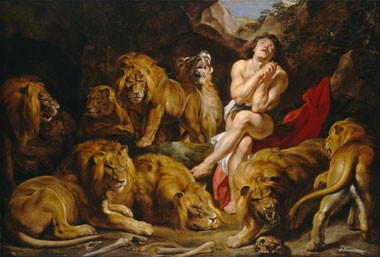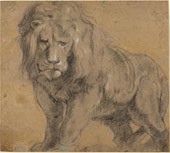Grade Level: 5–6
Students will learn the biblical story of Daniel in the lions’ den as an example of a man who showed quiet bravery and conviction to his beliefs. They will research a “quiet” hero/heroine from the twentieth century and write an essay about this person’s activism accompanying it with an illustration. Then, students will write a speech championing a personal cause they believe in.

Sir Peter Paul Rubens
Flemish, 1577–1640
Daniel in the Lions' Den, c. 1614/1616
oil on canvas, 268 x 374.7 x 15.2 cm (105 1/2 x 147 1/2 x 6 in.)
National Gallery of Art, Ailsa Mellon Bruce Fund
Curriculum Connections
Materials
Warm-Up Questions
Think of a time in your life when you have been very brave in a frightening situation. What was challenging you? Where were you at the time? Were you alone or with other people? What character traits helped to get you through?
Background
The Old Testament Book of Daniel recounts that the biblical hero was condemned to spend a night in the lions’ den for refusing to worship the Persian king Darius. Depicted here is the moment the following morning when, after the stone sealing the entrance was rolled away, Daniel was revealed giving thanks to God for having brought him through the night safely.

Sir Peter Paul Rubens
Flemish, 1577 - 1640
Lion, c. 1612-1613
black chalk, heightened with white, yellow chalk in the background, 25.2 x 28.3 cm (9 15/16 x 11 1/8 in.)
National Gallery of Art, Ailsa Mellon Bruce Fund
Rubens combined realism and theatricality to produce strong emotional impact. Several of the lions, for example, stare directly at the viewer. Because of the suggestion that the spectator shares the same space as the lions, the viewer is drawn into the painting and, like Daniel, is threatened by the ferocious beasts. The lions are portrayed full-sized on the huge canvas and are depicted realistically. The lions’ convincing sense of movement and their superbly rendered fur result from Rubens’ direct observation and sketches he made in the royal menagerie in Brussels.
Peter Paul Rubens was the most sought-after painter in northern Europe during the early seventeenth century. His rich colors, energetic brushwork, and lively compositions epitomize the exuberance of baroque art. Dominated by restless motion, his dynamic and emotional style is created through strong contrasts of light and color. He served the courts of Europe not only as a painter, but also as a diplomat, sometimes carrying out delicate negotiations while working on foreign commissions.
Guided Practice
Activity
Have students consider the many heroes/heroines who achieved their goals quietly. Then, they should research and make a list of some quiet heroes/heroines from this century, for example, Martin Luther King, Jr., Mahatma Gandhi, Rosa Parks, or Nelson Mandela. Ask them to choose one hero or heroine and write a few paragraphs on what makes him or her heroic. Students should draw a scene from the hero/heroine’s life to use as an illustration when they present their findings to the class. A good place for students to begin their research is the website www.myhero.com.
Extension
Now that students have learned about a real-life hero/heroine who brought about change in their community or nation as a whole, have them think about something they see as an injustice. It could be something as small as sibling rivalry or as big as world peace. Have them write a speech outlining the issue with positive solutions on how to fix it. What would their slogan be? How would they spread the word?
VA:Re7.1.5 Compare one's own interpretation of a work of art with the interpretation of others.
VA:Re7.2.5 Identify and analyze cultural associations suggested by visual imagery.
VA:Re8.1.5 Interpret art by analyzing characteristics of form and structure, contextual information, subject matter, visual elements, and use of media to identify ideas and mood conveyed.